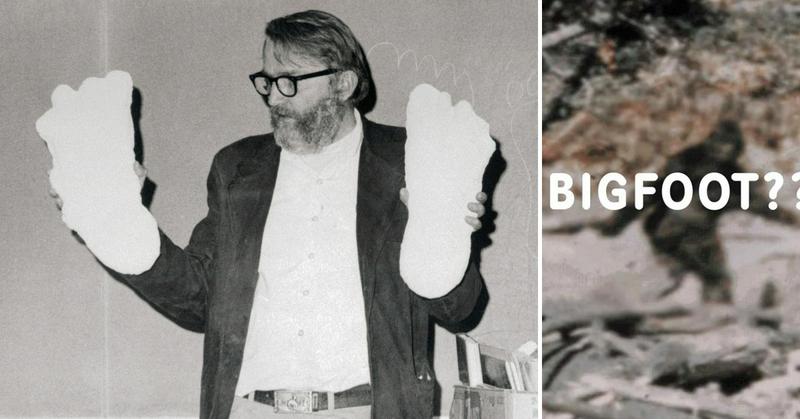The Bigfoot Craze Of The 1970s: The Monster As Elusive Celebrity
By | January 3, 2018

We all know "Bigfoot," or Sasquatch -- a giant hairy creature that resembles an ape but (maybe) walks like a man. This supposed creature has been said to exist, in one form or another, for hundreds of years, and in many different cultures all over the world. But in the United States, particularly in the '70s, belief in Bigfoot soared. Suddenly, a creature most people dismissed as a legend or a cryptid, was discussed in public as if it were real. And the public was gripped by a very real fear.
The idea of a giant man-ape in line with the Bigfoot story became popular in the U.S. in the early 1900s. By the time the 1960s was coming to an end, movies and documentaries began surfacing about Bigfoot. At the time, fact-checking and research was much harder to do than it is today -- news stories would be in the paper one day, and then the paper would be tossed in the trash. To put together a larger picture, and to check details over time, was a real skill practiced by journalists and academics, working with reams of microfiche and hard copies of old periodicals in dusty library archives. Rumors and hearsay, especially when combined with fear and hysteria, spread fast.
Reports Seemed To Agree On Bigfoot's Size And Shape

People who had reported a sighting of the creature described him similarly. Bigfoot was often assumed to be male. He was also described as being about 7 feet tall, weighing between 300 – 500 pounds. He walked upright and had dark hair covering his entire body with an ape-like face.
The Clip That Made Bigfoot A Craze

A short film from 1967 seemed to offer proof of Bigfoot -- well, proof to those willing to believe. Called the "Patterson-Gimlin Film," the brief clip shows a large hairy creature walking away from the camera, and it was filmed by Roger Patterson and Bob Gimlin. It was immediately embraced by Bigfoot believers, and drew fairly serious interest from some scientists. The general public, who might not have had an opinion on Bigfoot, were barraged by the film. It was shown on national talk shows, including those hosted by Joey Bishop, Merv Griffin, and Johnny Carson, often accompanied by an anthropologist offering thoughts on its possible validity.
The Patterson-Gimlin Film Fueled Confirmation Bias

Today, the Patterson-Gimlin film is generally considered to be a hoax, although some people still believe it. But its impact on the '70s Bigfoot phenomenon can't be overstated. The Patterson-Gimlin film raises the common flaw with paranormal phenomena: confirmation bias. Yes, the Bigfoots described by people had a lot in common, and also looked like the Bigfoot from the film. Did this make the film more likely to be authentic -- or did it just mean people had seen the film on TV talk shows?
Bigfoot Seemed To Be Everywhere

Newspaper articles began being published with disturbing headlines and pictures. Just the sight of the Bigfoot’s footprint was enough to shake up the country. Pictures surfaced supporting evidence that he had been nesting or bedding down in remote places. Then, pictures of Bigfoot himself started appearing. Most of the pictures of Bigfoot were taken from a distance and were of poor quality. The voice of reason told us that this was a hoax, but we just couldn’t take the chance.
People started keeping a closer eye on their kids and pets when they were outside. If ever a strange noise was heard in the night, Bigfoot was the first thing that came to mind. To make things worse, even well thought of and respected members of the community had reported seeing him.
And Then Came Bigfoot Movies

The movie The Legend of Boggy Creek came out in 1972, which added fuel to the fire. Our worst nightmares had been validated; or at the very least, not eased. The movie prayed on our ignorance and fears. It claimed to be a true story of the beast who was roaming the woods and creeks of Fouke, Arkansas. Bigfoot eventually gained worldwide fame by being known for menacing farmers, hunters and average citizens minding their own business. One account given by a farmer was that his 200-pound hog had been carried off. Another account showed a man relieving himself in the bathroom of his house at the time he fell victim. We were not safe anywhere!
We Don't Believe In Bigfoot Anymore. Or Do We?

Eventually, the Bigfoot craze settled down and we were able to breathe a little easier. That doesn’t mean that the sightings have stopped. Yes… they are still being reported today. According to folklore, Bigfoot is still roaming the woods of southern Arkansas. And Bigfoot will always be a source of entertainment, even if we can all (someday) agree it was a hoax -- after all, Harry and the Hendersons came out in the late 1980s, and was a huge hit.
